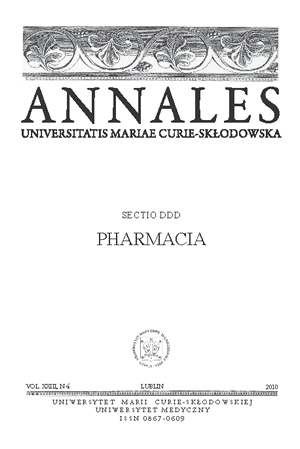Clinical picture versus concentration of triiodothyronine in patients with hypothyroidism
Keywords:
hypothyroidism, symptomatology, free triiodothyronine (fT3), free thyroxine (fT4)Abstract
Hypothyroidism may be asymptomatic, especially when subclinical, because typical symptoms of hypothyroidism are manifested in patients with a lower concentration of free triiodothyronine (fT3), whereas they are rare or may not be manifested in patients with a normal fT3 concentration but with a lower concentration of free thyroxine. The aim of the study was a retrospective analysis of symptomatology of hypothyroidism and search for a correlation with fT3 concentration of in blood serum. A total of 241 outpatients with hypothyroidism treated in 2009 (188 women, 53 men), mean age 55.4±15.6, were divided into two groups: group I: 151 patients with a normal fT3 concentration and group II: 90 patients with a lower fT3 concentration in blood serum at diagnosis. During a retrospective evaluation of patients' medical documentation, we searched for correlations between the clinical symptoms of hypothyroidism and fT3 concentration. The clinical picture of patients with hypothyroidism showed that typical symptoms appeared more frequently in group II, which, however, was of no statistical importance. The most commonly reported symptoms in this group were: weight gain 26.67%, drowsiness 24.44%, weakness 15.56% and dry skin 11.11%, whereas in group I non-typical hypothyroidism symptoms dominated – connected with circulatory system, i.e. symptoms of ischaemic heart disease 15.54% and arrhythmia 11.92%. In both groups similar values of the following manifestations were found (group I vs. group II): lipid disorders 43.71% vs. 42.22%, hypertension 32.45% vs. 31.11%, puffy eyes 7.28% vs. 6.67%, respectively. At diagnosis of hypothyroidism, the clinical picture does not correlate with the fT3 concentration in the studied group. Routine thyroid function testing remains the most reliable way to identify patients with thyroid failure.
References
1. Bianco A.C., Salvatore D., Gereben B. et al:. Biochemistry, cellular and molecular biology, and physiological roles of the iodothyronine selenodeiodinases. Endocr. Rev., 23, 38, 2002.
2. Billewicz W.Z., Chapman R.S., Crooks J. et al.: Statistical methods applied to the diagnosis of hypothyroidism. Q. J. Med., 38, 255, 1969.
3. Biondi B., Cooper D.S.: The clinical significance of subclinical thyroid dysfunction. Endocr. Rev., 829, 76, 2000.
4. Bjoro T., Holmen J., Krüger O. et al.: Prevalence of thyroid disease, thyroid dysfunction and thyroid peroxidase antibodies in a large, unselected population. The Health Study of Nord Trondelag (HUNT). Eur. J. Endocrinol., 143, 639, 2000.
5. Duntas LH, Mantzou E, Koutras DA. Circulating levels of oxidized low density lipoprotein in overt and mild hypothyroidism. Thyroid, 12, 1003, 2002.
6. Górowski T.: Choroby tarczycy. Wyd. trzecie. PZWL, Warszawa 1980.
7. Greenspan F.S.: Tharoid gland. In:., Gardner D. G. (ed.): Basic and clinical endocrinology. Lange Medical Books/Mc Graw-Hill, 218, 2001.
8. Hak A.E., Pols H.A.P., Visser T.J. et al.: Subclinical hypothyroidism is an independent risk factor for atherosclerosis and myocardial infarction in elderly women: The Rotterdam study. Ann. Intern. Med., 132, 270, 2000.
9. Kostoglou-Athanassiou I., Ntalles K.: Hypothyroidism – new aspects of an old disease. Hippokratia.,14, 82, 2010.
10. McDermott M.T., Ridgway E.C.: Subclinical hypothyroidism is mild thyroid failure and should be treated. J Clin Endocrinol Metab., 86, 4585, 2001.
11. Surks M.I., Ortiz E., Daniels G.H. et al.: Subclinical Thyroid Disease. Scientific Review and Guidelines for Diagnosis and Management. JAMA, 291, 228, 20004.
12. Vanderpump M.P., Tunbridge W.M.: Epidemiology and prevention of clinical and subclinical hypothyroidism. Thyroid, 12, 839, 2002.
13. Yen P.M.: Physiological and molecular basis of thyroid hormone action. Physiol. Rev., 81, 1097, 2001.
14. Zulewski H., Müller B., Exer P. et al.: Estimation of tissue hypothyroidism by a new clinical score: evaluation of patients with various grades of hypothyroidism and controls. J. Clin. Endocrinol. Metab., 82, 771, 1997.
Downloads
Published
Issue
Section
License
Copyright (c) 2010 Authors

This work is licensed under a Creative Commons Attribution-NonCommercial-NoDerivatives 3.0 Unported License.


